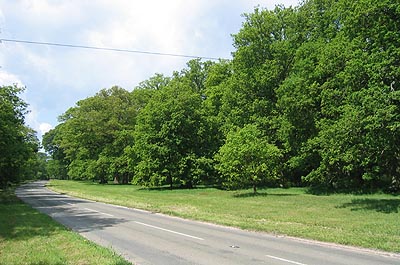 |
 |
|||
|
|
 The
Bucklebury Oaks The
Bucklebury OaksThe Queens' Avenues This noble avenue is over a mile in length, and some of the trees are of gigantic growth, and of most picturesque character. Prom their huge trunks, boughs of a size little inferior to the parent stem throw far and wide their horizontal shade, while their no less massive roots show at once the tenacity of their growth, and the splendour of their luxurious foliage. There is a tradition that the trees were planted to commemorate a visit of Queen Anne to Bucklebury, but it is far more probable they have some association with a visit of Queen Elizabeth, as also stated. The Queen certainly visited Mr. Henry Winchcombe at Newbury, in 1568, and she may have taken Bucklebury on her road from Englefield. However this maybe, this great avenue was planted as an approach to the old mansion, and from the Blade-Bone Inn was continued down Chapel Row Hill, several fine oaks corresponding to those in the avenue still standing by the side of the road, and the site of the entrance gate to the old Manor-house can still be seen. The outer line of trees was planted to commemorate the victory of Waterloo, in 1815, also those with mounds round them by Nuttage Gate. The late Mr. W. H. H. Hartley mentioned to the writer that when his grandfather came into the estate many of the oldest and most venerable of the oaks on the estate must have dated back to a time anterior to the dissolution of Reading Abbey, and there are still a few of these patriarchs of the grove remaining. It is also worthy of record that the longest and finest mast ever turned out at Portsmouth Dockyard was cut from an oak grown on the Bucklebury estate. At this time when British oak was in such demand for the "Wooden walls of Old England," Mr. Hartley was offered an immense sum for the whole of the trees in the avenue, but he nobly refused to destroy what time had "consecrated, and the hand of taste displayed by his ancestors had preserved from violation. From an old booklet, author unknown. |
|||
| © Nash Ford Publishing 2001. All Rights Reserved. | ||||


